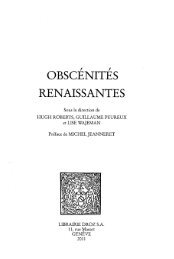Download (3398Kb) - ePrints Soton - University of Southampton
Download (3398Kb) - ePrints Soton - University of Southampton
Download (3398Kb) - ePrints Soton - University of Southampton
Create successful ePaper yourself
Turn your PDF publications into a flip-book with our unique Google optimized e-Paper software.
juvenile survivorship (small eggs). They inhabit predictable and seasonal<br />
environments (Winemiller and Rose, 1992; McCann and Shuter, 1997).<br />
The opportunistic life-history strategy shows most <strong>of</strong> the classical traits <strong>of</strong> the<br />
r strategy, with small body size, early maturation, low juvenile survivorship and short<br />
lifespan, although it differs in that fecundity per spawning event is low. The<br />
opportunistic strategists maximize population growth through a reduction in the mean<br />
time <strong>of</strong> generation (Ramirez-Llodra, 2002). Early maturation results in a short lifespan<br />
and high population yield but diminishes their capability to produce a large quantity<br />
<strong>of</strong> <strong>of</strong>fspring per event and large eggs. However, because <strong>of</strong> their multiple spawning<br />
frequencies, annual fecundity is high and allows for colonization <strong>of</strong> new habitats.<br />
These organisms inhabit highly disturbed and unpredictable environments<br />
(Winemiller and Rose, 1992; McCann and Shuter, 1997).<br />
In the Winemiller-Rose model, K strategy is redefined as the equilibrium<br />
strategy and its boundaries are constrained. The equilibrium strategists have moderate<br />
age at maturity, low fecundity and high juvenile survivorship determined by a large<br />
egg size. They differ from the classical K strategists in that they have small to<br />
medium body sizes (Ramirez-Llodra, 2002). The species that evolve in the<br />
equilibrium strategy maximize juvenile survivorship at the expense <strong>of</strong> fecundity. They<br />
inhabit constant environments ((Winemiller and Rose, 1992; McCann and Shuter,<br />
1997).<br />
The production <strong>of</strong> eggs is a high energy-demanding process. Therefore, the<br />
accessibility <strong>of</strong> food plays an essential role before and during the process <strong>of</strong> egg<br />
production (Eckelbarger, 1986; Chia and Walker, 1991). The process <strong>of</strong> vitellogenesis<br />
consumes a large proportion <strong>of</strong> the energy intake <strong>of</strong> an organism, and this requirement<br />
84
















